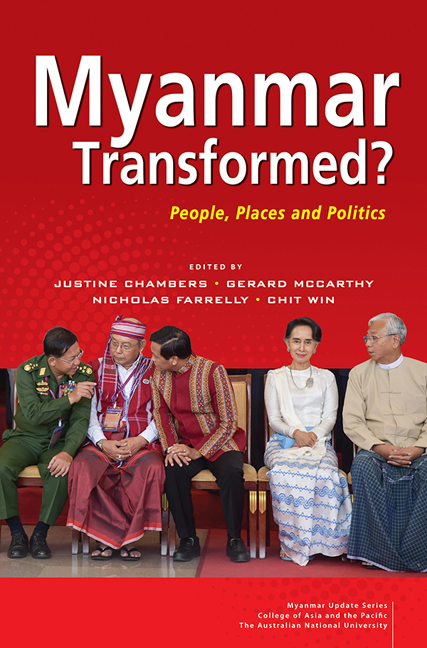Book contents
- Frontmatter
- Contents
- List of Tables
- List of Figuress
- Acknowledgements
- Contributors and Editors
- Part I Introduction
- Part II People
- Part III Places
- Part IV Politics
- 9 Partnership in Politics: The Tatmadaw and the NLD in Myanmar since 2016
- 10 From Ceasefire to Dialogue: The Problem of “All-Inclusiveness” in Myanmar's Stalled Peace Process
- 11 Securitization of the Rohingya in Myanmar
- 12 Forming an Inclusive National Identity in Myanmar: Voices of Mon People
- Part V Epilogue
- Abbreviations and Key Terms
- Index
9 - Partnership in Politics: The Tatmadaw and the NLD in Myanmar since 2016
from Part IV - Politics
Published online by Cambridge University Press: 12 February 2019
- Frontmatter
- Contents
- List of Tables
- List of Figuress
- Acknowledgements
- Contributors and Editors
- Part I Introduction
- Part II People
- Part III Places
- Part IV Politics
- 9 Partnership in Politics: The Tatmadaw and the NLD in Myanmar since 2016
- 10 From Ceasefire to Dialogue: The Problem of “All-Inclusiveness” in Myanmar's Stalled Peace Process
- 11 Securitization of the Rohingya in Myanmar
- 12 Forming an Inclusive National Identity in Myanmar: Voices of Mon People
- Part V Epilogue
- Abbreviations and Key Terms
- Index
Summary
The year 2016 was a milestone in the political history of Myanmar as it gave birth to a popularly elected civilian government for the first time since the military takeover of the state in March 1962. In the elections held on 8 November 2015, it was clear within a few hours that the National League for Democracy (NLD) had won a landslide victory. When the result was finalized, the NLD won 57.20 per cent of valid votes (12.79 million) for the Pyithu Hluttaw (House of Representatives) and 78.95 per cent of contested seats (323 seats). Similarly, for the Amyotha Hluttaw (House of Nationalities), the party won 57.68 per cent (13.10 million) of the valid votes and 80.36 per cent of contested seats (168 seats). The 2008 Constitution is essentially designed by the military to require partnership with civilian politicians, allocating twenty-five per cent of the seats in both houses to military members and allowing the military to nominate a vicepresidential candidate along with ministers for Defence, Home Affairs and Border Affairs. In a mix of parliamentary and presidential systems, the NLD's nominee Htin Kyaw became the president and the Tatmadaw's nominees, ex-general Myint Swe, and the other NLD nominee, Henry Van Thio, became vice-presidents. In this constitutional setting and with the results of the 2015 election, the NLD has become a ruling partner for the Tatmadaw.
In his inaugural address, President Htin Kyaw pledged that his government would “implement four policies: national reconciliation; internal peace; the emergence of a constitution that will produce a democratic, federal union; and the improvement of the quality of life of the majority of the people”. At the same time, he cautiously stated: “I am responsible for the emergence of a constitution that will be in accord with the democratic norms suited to our country. I am also aware that I need to be patient in realizing this political objective, for which the people have long aspired” (GNLM 2016, p. 1).
In order to streamline the cabinet size, the NLD government initially reduced the numbers in the ministry from twenty-eight to twenty-one, yet it created the Ministry of Ethnic Affairs, and the number of ministers was reduced from thirty-two to eighteen with no deputy ministers. At that point in time, Aung San Suu Kyi herself held four ministerial portfolios.
- Type
- Chapter
- Information
- Myanmar Transformed?People, Places and Politics, pp. 201 - 230Publisher: ISEAS–Yusof Ishak InstitutePrint publication year: 2018

